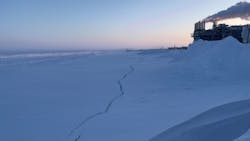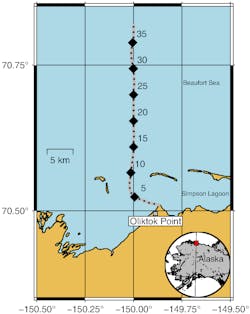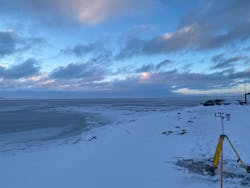Sensing method uses fiber-optic cable to track sea ice
Researchers at the University of New Mexico (UNM; Albuquerque, NM) are using techniques and technology already established for telecommunications and the oil and gas industry. The team has tapped into a telecommunications fiber-optic cable on the sea floor off the shore of Oliktok Point in northern Alaska to keep tabs on the sea ice (see Fig. 1 and video).
“Fiber-optic cables can be used not only to provide high-speed data connections, but also to measure ground vibrations along the cable,” says Andres Felipe Peña Castro, a postdoctoral researcher at UNM.
The work, which focused on a 37-km (23-mile) section of the fiber-optic cable, was conducted during periods of transitional sea ice coverage between July and November (see Fig. 2).
Adjoining approaches
Peña Castro’s team connected a distributed acoustic sensing (DAS) interrogator to one end of the fiber-optic cable, which sends light pulses throughout. The light pulses bounce back at multiple points along the cable, and the reflected light is measured by the interrogator. It tells researchers how much deformation occurs along the entire cable every few meters, Peña Castro explains, noting that DAS generates large amounts of data and records multiple processes. By examining changes in the timing of the reflected pulses, they can better understand the seismic waves that result.
“We use the fiber-optic cable to identify different signals that might emerge from the interaction between the ocean, the earth, and even the atmosphere,” Peña Castro says. “Some of these signals could be the local sea state and storm surges, sea ice fracturing, and shoaling. We wanted to objectively identify the major types of signals in the data.”
The technique recorded ambient seismic noise and changes in sea ice cover in fine spatiotemporal detail—something the researchers didn’t expect (see Fig. 3). They also didn’t expect how quickly these changes happen, with abrupt changes observed up to about 10 km in less than 24 hours.
Sea ice changes are typically obtained via satellite imagery, but the observations made using this conventional approach are limited by constraints regarding temporal resolution—on a broader scale on the order of days. The spatial resolution of satellites to observe sea ice is also limited.
“We show that fiber-optic cables are capable of recording sea ice extent changes with higher resolution (minutes and meters),” Peña Castro says. “And they’re only limited to where the fiber-optic cable is installed, at a local scale.”
Using machine learning, the researchers identified possible patterns in their data, as well as the major types of signals in the data—without assuming how many signals or which signals would be dominant.
The team is also investigating other phenomena including signals generated by icequakes, vessels, and marine mammals.
“Changes in sea ice is one of the indicators of climate change,” Peña Castro says. “In general, measuring sea ice extent is limited to satellite observations, but we show that fiber-optic cables deployed in the Arctic would help to constrain measurements of sea ice at a higher detail.”
About the Author
Justine Murphy
Multimedia Director, Digital Infrastructure
Justine Murphy is the multimedia director for Endeavor Business Media's Digital Infrastructure Group. She is a multiple award-winning writer and editor with more 20 years of experience in newspaper publishing as well as public relations, marketing, and communications. For nearly 10 years, she has covered all facets of the optics and photonics industry as an editor, writer, web news anchor, and podcast host for an internationally reaching magazine publishing company. Her work has earned accolades from the New England Press Association as well as the SIIA/Jesse H. Neal Awards. She received a B.A. from the Massachusetts College of Liberal Arts.



